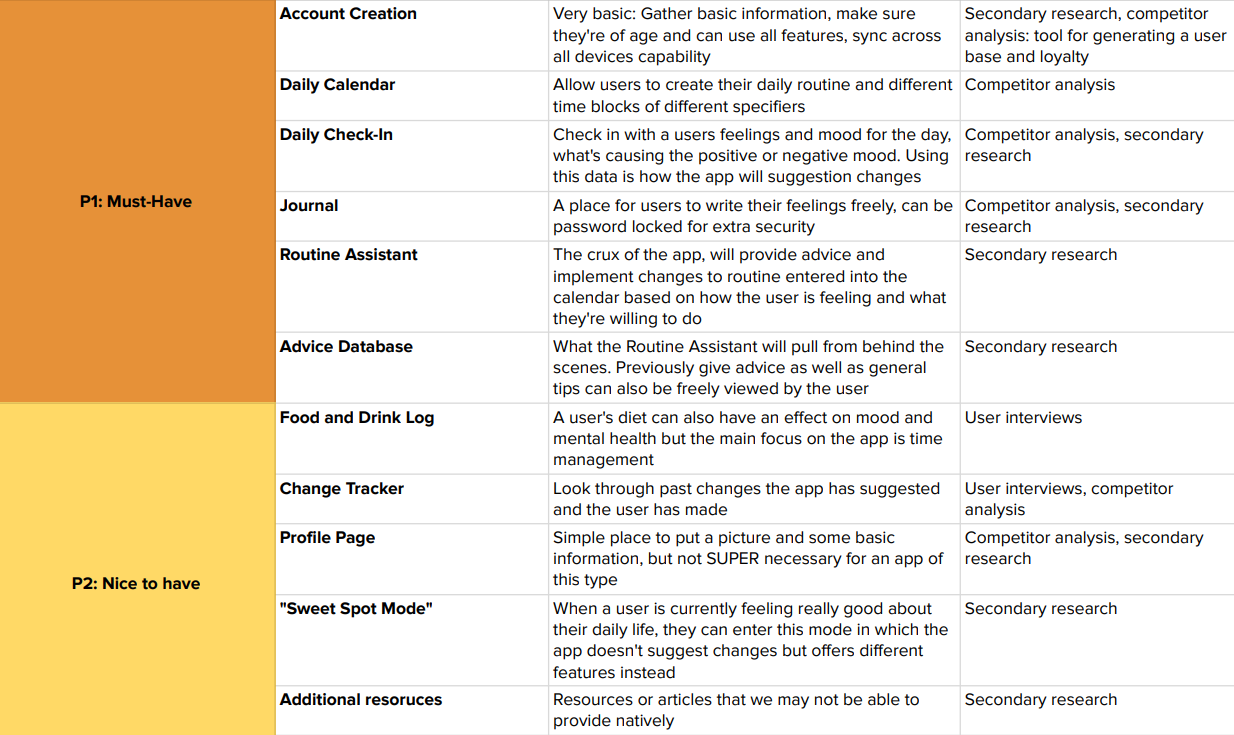YourTempo
Product: iOS app
Scope: End-to-end mobile app
Responsibilities: User research and testing, branding, visual design
Timeline: October 2023 (80 hours)
Background
In the modern era, the average person has a packed schedule. Trying to balance a job or career, a social life, relaxation, and health can be a lot but is also what is a societal expectation. With this immense balancing act also comes problems with how to balance things in a way that doesn’t compromise one’s mental health. YourTempo is an app intended to help anyone with their day-to-day life and live happily while still being able to manage all their responsibilities. The main draw of YourTempo is the routine assistant, who helps users move time around in their schedules and offers advice based on reported feelings and moods in a daily check-in.
Problem
The average person has a packed schedule every day and with rising external pressures from different avenues, there is bound to be a significant amount of stress and anxiety. With so many being entrenched in their busy lives, people need outside help to lead happier and healthier lives.
Mission
We want to know how users manage a busy schedule by themselves and how different schedules can affect mood and mental health.
Primary Research
Primary research mainly involved user interviews to evaluate how users would use mental health features in relation to their everyday routines
Illuminated a strong link between a user’s mental health and the intensity of their everyday routines
Users expressed strong interest in an application that would assist them in changing their routines for the better
Synthesis of user findings was made with creation of personas and affinity mapping
Secondary Research
Secondary research proved there were no direct competitors on the market and was instead used to analyze common features from similar apps.
Common features included calendar and journal functionality, the latter of which was not considered before performing the research
None of the other apps featured a digital assistant to aid with mental health and routine problems
Competitive analysis chart
Laying the Foundation
With the research findings in hand, we were able to use these to prioritize important features and functionality that could be present in the app
It was important to emphasize the unique parts of the app that would set it apart from other competitors, like the routine assistant.
Journal functionality jumped up in priority when analyzing how prominent it was in other competitor offerings.
Task and user flows were created for the most important features to visualize the ideal user journey.
A portion of the feature set created
Example task and user flows (reorganized for readability)
Wireframing
Low-Fidelity Wireframing
Going into the wireframing stage, I knew I wanted to create something that had some charm to it and felt rather “gentle”. After all, this app’s intent is to help those who are stressed and overwhelmed. Rounded edges and clean sections were my go-to to relieve any visual harshness
Mid-Fidelity Wireframing
Feedback given on the low-fidelity wireframes was just what I was hoping for. Some even said the app felt familiar because it reminded them of other calendars they’d used before and liked. I was in the clear to begin digitizing the low-fidelity wireframes.
Branding
Branding would be very important as to not only entice users, but also to make them feel comfortable and uplifted as they used the platform
The logo has a stereotypical alarm clock with a heart for added warmth and demonstration of care for the user
Purples invoke a dreamy and light feeling, with pastels accenting the rest of the palette to keep things fun and not too serious
Text is always kept readable and simple, the focus is on the user’s routine and potential improvements.
High fidelity wireframes could only be created once all parts created before in the process were at least satisfactory
These high-fidelity wireframes would go on to become a working prototype for usability testing
Other concepts bloomed during the creation of the wireframes, such as the home screen and journal appearance
Prototyping & Usability Testing
Usability testing is one of the most important parts of the design process and where I could gather extremely impactful feedback from users about the prototype.
There was a lack of navigation functions on the journal screens that I had overlooked but users caught
There was a large desire for additional viewing functionality on the calendar screens
There was much positive feedback about the overall design and uniqueness of the routine assistant
Final Revisions
With the usability testing results analyzed, common themes pulled out and highest impact changes identified, final revisions were able to be made.
Notable changes were as follows:
Changed home screen widget color
Unified font color on home screen
Decreased size of footer navigation bar
Added duration on each calendar time block
Darkened selectable colors for time blocks
Increased text size for chatting with the routine assistant
Added a pop-up that details any changes your routine assistant made to your calendar
Added more navigation to the journal entries
Added a notes section that can be freely filled in on the daily check-in
Takeaways
As of now, this is the most recent project that I have worked on and the one I am the most proud of. Not only did I come up with the idea for the application on my own, but I also think I did a fairly good job of realizing the concept and can see it being something people use to improve their lives on a daily basis. I’m also proud of the visual design of the product. It got great feedback in usability testing and I believe the visual style of the app is one of my most appealing designs. Creating and designing products that can aid anyone’s life, even in small ways, energizes me the most to continue designing and I hope to continue to grow my skills constantly by designing for the user and the life they want to live.









